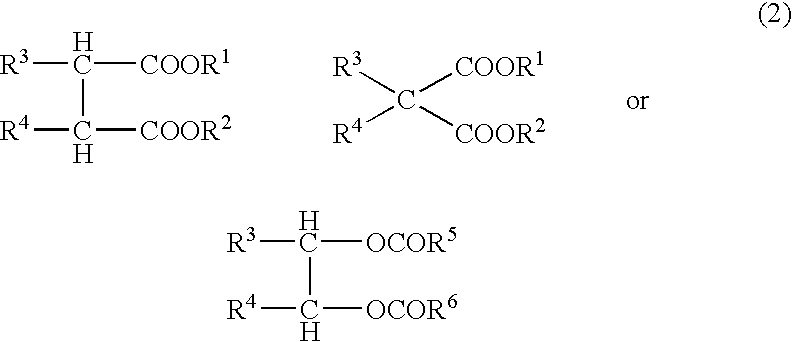Resin composition based on crystalline polypropylene
a technology of polypropylene and resin composition, which is applied in the direction of film/foil adhesives, mixing, chemistry apparatus and processes, etc., can solve the problems that the above-mentioned polypropylene resin composition may occasionally suffer from the appearance deterioration of the molded product, and may cause the appearance deterioration of the above-mentioned polypropylene resin composition
- Summary
- Abstract
- Description
- Claims
- Application Information
AI Technical Summary
Benefits of technology
Problems solved by technology
Method used
Image
Examples
production example 1
Polymerization of Crystalline Polypropylene [1]
(1) Preparation of Titanium-based Solid Catalyst Component [1]
A vibration mill provided with four crusher pots having each an internal volume of 4 liters containing 9 kg of steel balls of a diameter of 12 mm was employed. Each pot was charged with 300 g of magnesium chloride, 115 ml of diisobutyl phthalate and 60 ml of titanium tetrachloride and the charged contents were subjected to crushing for 40 hours under a nitrogen atmosphere. 5 g of the resulting co-crushed mixture were placed in a 200 ml flask, whereto 100 ml of toluene were added and the mixture was agitated at 114.degree. C. for 30 minutes and, then, was stood still and the supernatant was removed. The resulting solid matter was then washed three times with each 100 ml of n-heptane at 20.degree. C. and the so-washed product was suspended in 100 ml of n-heptane to obtain a titanium-based solid catalyst slurry. This titanium-based solid catalyst had a titanium content of 2.0% b...
production examples 2-12
The same procedures as in Production Example 1 were pursued to produce crystalline polypropylene products Y-2, Y-3 and Y-7 to Y-15, except that the polymerization condition was altered to that given in Table 11. The results are recite in Tables 12 and 13.
production example 13
Polymerization of Crystalline Polypropylene Product Y-6
The procedures of Production Example 1 were pursued except that 1.2 mmoles of cyclohexylmethyldimethoxysilane (CMMS) were used instead of the dicyclopentyldimethoxysilane (DCPMS) used in Production Example 1, whereby a crystalline polypropylene product Y-6 was obtained. The material properties thereof are recited in Table 12.
PUM
| Property | Measurement | Unit |
|---|---|---|
| melt flow rate | aaaaa | aaaaa |
| molecular weight distribution | aaaaa | aaaaa |
| melt flow rate | aaaaa | aaaaa |
Abstract
Description
Claims
Application Information
 Login to View More
Login to View More - R&D
- Intellectual Property
- Life Sciences
- Materials
- Tech Scout
- Unparalleled Data Quality
- Higher Quality Content
- 60% Fewer Hallucinations
Browse by: Latest US Patents, China's latest patents, Technical Efficacy Thesaurus, Application Domain, Technology Topic, Popular Technical Reports.
© 2025 PatSnap. All rights reserved.Legal|Privacy policy|Modern Slavery Act Transparency Statement|Sitemap|About US| Contact US: help@patsnap.com



